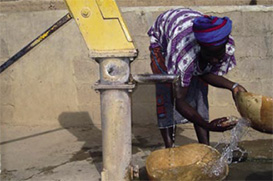Planning for Drinking Water and Sanitation in Peri-Urban Areas
Safe drinking water, good sanitation and hygiene are fundamental to people's health, survival, growth and development. In some parts of the world, the supply of water and sanitation is part of the existing technical infrastructure. However, in many developing countries the situation is quite different and planning and implementing of an adequate supply is an important task. In Planning for Drinking Water and Sanitation in Peri-Urban Areas, the Swedish Water House assesses the challenges in these areas and presents a potential framework for sustainable planning.

Safe drinking water, good sanitation and hygiene are fundamental to people’s health, survival, growth and development. In some parts of the world, the supply of water and sanitation is part of the existing technical infrastructure. However, in many developing countries the situation is quite different and planning and implementing of an adequate supply is an important task. In Planning for Drinking Water and Sanitation in Peri-Urban Areas, the Swedish Water House assesses the challenges in these areas and presents a potential framework for sustainable planning.
KEY LESSONS LEARNED
- Peri-urban areas vary greatly from area to area. So, any planning must be adapted specifically to the local context and should consider the fact that, as populations grow and settlements increase in size, they will begin to compete with neighbouring settlements.
- Adaptive planning requires a holistic approach. So, any definition of a water and sanitation system should include the technical structure, the organisation (both formal and informal), and the users. By the same token, any comprehensive analysis of sustainability should cover the following issues: health, the environment, the economy, socio-culture factors and technical function.
- Lack of knowledge, uncertainties, priorities and reasons for those priorities needs to be identified. Therefore, it is imperative to involve local stakeholders from all levels, ranging from the household to the district and city level, as early on as possible.
- The Strategic Choice Approach (SCA) can be used to guide efforts to choose sustainable water and wastewater systems in an iterative process that includes: shaping the problem focus, designing potential strategies for addressing problems, comparing those strategies, and finally choosing a strategy to be implemented.
How to Cite:
Norström, A. Planning for Drinking Water and Sanitation in Peri-Urban Areas. Swedish Water House Report 21. SIWI, 2007.
(the main author is Dr. Anna Norström of CIT Urban Water Management AB. Contributing authors and reviewers include Dr. Per-Arne Malmqvist, Chalmers University of Technology; Ms. Cecilia Martinsen and Mr. Manfred Matz, Stockholm International Water Institute; Ms. Karin Lexén, Swedish Water House; Ms. Barbara Evans, Independent Consultant; Dr. Jaan-Henrik Kain and Ms. Christina Lundéhn, Chalmers University of Technology; Dr. HB Wittgren, Linköping University; Dr. Erik Kärrman, Ecoloop; and Dr. Elisabeth Kvarnström, Stockholm Environment Institute)



